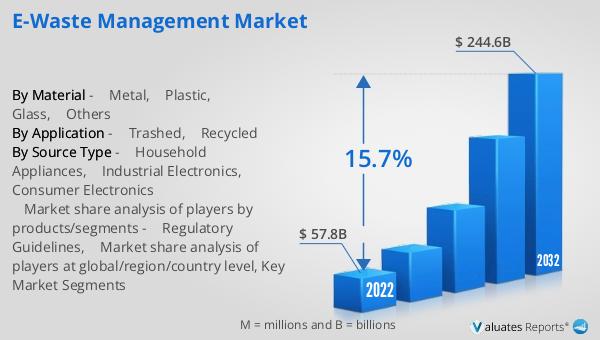LIST OF TABLES
TABLE 01. GLOBAL E-WASTE MANAGEMENT MARKET, BY MATERIAL, 2022-2032 ($MILLION)
TABLE 02. E-WASTE MANAGEMENT MARKET FOR METAL, BY REGION, 2022-2032 ($MILLION)
TABLE 03. E-WASTE MANAGEMENT MARKET FOR PLASTIC, BY REGION, 2022-2032 ($MILLION)
TABLE 04. E-WASTE MANAGEMENT MARKET FOR GLASS, BY REGION, 2022-2032 ($MILLION)
TABLE 05. E-WASTE MANAGEMENT MARKET FOR OTHERS, BY REGION, 2022-2032 ($MILLION)
TABLE 06. GLOBAL E-WASTE MANAGEMENT MARKET, BY SOURCE TYPE, 2022-2032 ($MILLION)
TABLE 07. E-WASTE MANAGEMENT MARKET FOR HOUSEHOLD APPLIANCES, BY REGION, 2022-2032 ($MILLION)
TABLE 08. E-WASTE MANAGEMENT MARKET FOR INDUSTRIAL ELECTRONICS, BY REGION, 2022-2032 ($MILLION)
TABLE 09. E-WASTE MANAGEMENT MARKET FOR CONSUMER ELECTRONICS, BY REGION, 2022-2032 ($MILLION)
TABLE 10. GLOBAL E-WASTE MANAGEMENT MARKET, BY APPLICATION, 2022-2032 ($MILLION)
TABLE 11. E-WASTE MANAGEMENT MARKET FOR TRASHED, BY REGION, 2022-2032 ($MILLION)
TABLE 12. E-WASTE MANAGEMENT MARKET FOR RECYCLED, BY REGION, 2022-2032 ($MILLION)
TABLE 13. E-WASTE MANAGEMENT MARKET, BY REGION, 2022-2032 ($MILLION)
TABLE 14. NORTH AMERICA E-WASTE MANAGEMENT MARKET, BY MATERIAL, 2022-2032 ($MILLION)
TABLE 15. NORTH AMERICA E-WASTE MANAGEMENT MARKET, BY SOURCE TYPE, 2022-2032 ($MILLION)
TABLE 16. NORTH AMERICA E-WASTE MANAGEMENT MARKET, BY APPLICATION, 2022-2032 ($MILLION)
TABLE 17. NORTH AMERICA E-WASTE MANAGEMENT MARKET, BY COUNTRY, 2022-2032 ($MILLION)
TABLE 18. U.S. E-WASTE MANAGEMENT MARKET, BY MATERIAL, 2022-2032 ($MILLION)
TABLE 19. U.S. E-WASTE MANAGEMENT MARKET, BY SOURCE TYPE, 2022-2032 ($MILLION)
TABLE 20. U.S. E-WASTE MANAGEMENT MARKET, BY APPLICATION, 2022-2032 ($MILLION)
TABLE 21. CANADA E-WASTE MANAGEMENT MARKET, BY MATERIAL, 2022-2032 ($MILLION)
TABLE 22. CANADA E-WASTE MANAGEMENT MARKET, BY SOURCE TYPE, 2022-2032 ($MILLION)
TABLE 23. CANADA E-WASTE MANAGEMENT MARKET, BY APPLICATION, 2022-2032 ($MILLION)
TABLE 24. EUROPE E-WASTE MANAGEMENT MARKET, BY MATERIAL, 2022-2032 ($MILLION)
TABLE 25. EUROPE E-WASTE MANAGEMENT MARKET, BY SOURCE TYPE, 2022-2032 ($MILLION)
TABLE 26. EUROPE E-WASTE MANAGEMENT MARKET, BY APPLICATION, 2022-2032 ($MILLION)
TABLE 27. EUROPE E-WASTE MANAGEMENT MARKET, BY COUNTRY, 2022-2032 ($MILLION)
TABLE 28. UK E-WASTE MANAGEMENT MARKET, BY MATERIAL, 2022-2032 ($MILLION)
TABLE 29. UK E-WASTE MANAGEMENT MARKET, BY SOURCE TYPE, 2022-2032 ($MILLION)
TABLE 30. UK E-WASTE MANAGEMENT MARKET, BY APPLICATION, 2022-2032 ($MILLION)
TABLE 31. GERMANY E-WASTE MANAGEMENT MARKET, BY MATERIAL, 2022-2032 ($MILLION)
TABLE 32. GERMANY E-WASTE MANAGEMENT MARKET, BY SOURCE TYPE, 2022-2032 ($MILLION)
TABLE 33. GERMANY E-WASTE MANAGEMENT MARKET, BY APPLICATION, 2022-2032 ($MILLION)
TABLE 34. FRANCE E-WASTE MANAGEMENT MARKET, BY MATERIAL, 2022-2032 ($MILLION)
TABLE 35. FRANCE E-WASTE MANAGEMENT MARKET, BY SOURCE TYPE, 2022-2032 ($MILLION)
TABLE 36. FRANCE E-WASTE MANAGEMENT MARKET, BY APPLICATION, 2022-2032 ($MILLION)
TABLE 37. ITALY E-WASTE MANAGEMENT MARKET, BY MATERIAL, 2022-2032 ($MILLION)
TABLE 38. ITALY E-WASTE MANAGEMENT MARKET, BY SOURCE TYPE, 2022-2032 ($MILLION)
TABLE 39. ITALY E-WASTE MANAGEMENT MARKET, BY APPLICATION, 2022-2032 ($MILLION)
TABLE 40. SPAIN E-WASTE MANAGEMENT MARKET, BY MATERIAL, 2022-2032 ($MILLION)
TABLE 41. SPAIN E-WASTE MANAGEMENT MARKET, BY SOURCE TYPE, 2022-2032 ($MILLION)
TABLE 42. SPAIN E-WASTE MANAGEMENT MARKET, BY APPLICATION, 2022-2032 ($MILLION)
TABLE 43. REST OF EUROPE E-WASTE MANAGEMENT MARKET, BY MATERIAL, 2022-2032 ($MILLION)
TABLE 44. REST OF EUROPE E-WASTE MANAGEMENT MARKET, BY SOURCE TYPE, 2022-2032 ($MILLION)
TABLE 45. REST OF EUROPE E-WASTE MANAGEMENT MARKET, BY APPLICATION, 2022-2032 ($MILLION)
TABLE 46. ASIA-PACIFIC E-WASTE MANAGEMENT MARKET, BY MATERIAL, 2022-2032 ($MILLION)
TABLE 47. ASIA-PACIFIC E-WASTE MANAGEMENT MARKET, BY SOURCE TYPE, 2022-2032 ($MILLION)
TABLE 48. ASIA-PACIFIC E-WASTE MANAGEMENT MARKET, BY APPLICATION, 2022-2032 ($MILLION)
TABLE 49. ASIA-PACIFIC E-WASTE MANAGEMENT MARKET, BY COUNTRY, 2022-2032 ($MILLION)
TABLE 50. CHINA E-WASTE MANAGEMENT MARKET, BY MATERIAL, 2022-2032 ($MILLION)
TABLE 51. CHINA E-WASTE MANAGEMENT MARKET, BY SOURCE TYPE, 2022-2032 ($MILLION)
TABLE 52. CHINA E-WASTE MANAGEMENT MARKET, BY APPLICATION, 2022-2032 ($MILLION)
TABLE 53. JAPAN E-WASTE MANAGEMENT MARKET, BY MATERIAL, 2022-2032 ($MILLION)
TABLE 54. JAPAN E-WASTE MANAGEMENT MARKET, BY SOURCE TYPE, 2022-2032 ($MILLION)
TABLE 55. JAPAN E-WASTE MANAGEMENT MARKET, BY APPLICATION, 2022-2032 ($MILLION)
TABLE 56. INDIA E-WASTE MANAGEMENT MARKET, BY MATERIAL, 2022-2032 ($MILLION)
TABLE 57. INDIA E-WASTE MANAGEMENT MARKET, BY SOURCE TYPE, 2022-2032 ($MILLION)
TABLE 58. INDIA E-WASTE MANAGEMENT MARKET, BY APPLICATION, 2022-2032 ($MILLION)
TABLE 59. AUSTRALIA E-WASTE MANAGEMENT MARKET, BY MATERIAL, 2022-2032 ($MILLION)
TABLE 60. AUSTRALIA E-WASTE MANAGEMENT MARKET, BY SOURCE TYPE, 2022-2032 ($MILLION)
TABLE 61. AUSTRALIA E-WASTE MANAGEMENT MARKET, BY APPLICATION, 2022-2032 ($MILLION)
TABLE 62. SOUTH KOREA E-WASTE MANAGEMENT MARKET, BY MATERIAL, 2022-2032 ($MILLION)
TABLE 63. SOUTH KOREA E-WASTE MANAGEMENT MARKET, BY SOURCE TYPE, 2022-2032 ($MILLION)
TABLE 64. SOUTH KOREA E-WASTE MANAGEMENT MARKET, BY APPLICATION, 2022-2032 ($MILLION)
TABLE 65. REST OF ASIA-PACIFIC E-WASTE MANAGEMENT MARKET, BY MATERIAL, 2022-2032 ($MILLION)
TABLE 66. REST OF ASIA-PACIFIC E-WASTE MANAGEMENT MARKET, BY SOURCE TYPE, 2022-2032 ($MILLION)
TABLE 67. REST OF ASIA-PACIFIC E-WASTE MANAGEMENT MARKET, BY APPLICATION, 2022-2032 ($MILLION)
TABLE 68. LAMEA E-WASTE MANAGEMENT MARKET, BY MATERIAL, 2022-2032 ($MILLION)
TABLE 69. LAMEA E-WASTE MANAGEMENT MARKET, BY SOURCE TYPE, 2022-2032 ($MILLION)
TABLE 70. LAMEA E-WASTE MANAGEMENT MARKET, BY APPLICATION, 2022-2032 ($MILLION)
TABLE 71. LAMEA E-WASTE MANAGEMENT MARKET, BY COUNTRY, 2022-2032 ($MILLION)
TABLE 72. LATIN AMERICA E-WASTE MANAGEMENT MARKET, BY MATERIAL, 2022-2032 ($MILLION)
TABLE 73. LATIN AMERICA E-WASTE MANAGEMENT MARKET, BY SOURCE TYPE, 2022-2032 ($MILLION)
TABLE 74. LATIN AMERICA E-WASTE MANAGEMENT MARKET, BY APPLICATION, 2022-2032 ($MILLION)
TABLE 75. MIDDLE EAST E-WASTE MANAGEMENT MARKET, BY MATERIAL, 2022-2032 ($MILLION)
TABLE 76. MIDDLE EAST E-WASTE MANAGEMENT MARKET, BY SOURCE TYPE, 2022-2032 ($MILLION)
TABLE 77. MIDDLE EAST E-WASTE MANAGEMENT MARKET, BY APPLICATION, 2022-2032 ($MILLION)
TABLE 78. AFRICA E-WASTE MANAGEMENT MARKET, BY MATERIAL, 2022-2032 ($MILLION)
TABLE 79. AFRICA E-WASTE MANAGEMENT MARKET, BY SOURCE TYPE, 2022-2032 ($MILLION)
TABLE 80. AFRICA E-WASTE MANAGEMENT MARKET, BY APPLICATION, 2022-2032 ($MILLION)
TABLE 81. ENVIRO-HUB HOLDINGS LTD.: KEY EXECUTIVES
TABLE 82. ENVIRO-HUB HOLDINGS LTD.: COMPANY SNAPSHOT
TABLE 83. ENVIRO-HUB HOLDINGS LTD.: SERVICE SEGMENTS
TABLE 84. ENVIRO-HUB HOLDINGS LTD.: PRODUCT PORTFOLIO
TABLE 85. TES AMM: KEY EXECUTIVES
TABLE 86. TES AMM: COMPANY SNAPSHOT
TABLE 87. TES AMM: SERVICE SEGMENTS
TABLE 88. TES AMM: PRODUCT PORTFOLIO
TABLE 89. TES AMM: KEY STRATERGIES
TABLE 90. CAPITAL ENVIRONMENT HOLDINGS LIMITED: KEY EXECUTIVES
TABLE 91. CAPITAL ENVIRONMENT HOLDINGS LIMITED: COMPANY SNAPSHOT
TABLE 92. CAPITAL ENVIRONMENT HOLDINGS LIMITED: SERVICE SEGMENTS
TABLE 93. CAPITAL ENVIRONMENT HOLDINGS LIMITED: PRODUCT PORTFOLIO
TABLE 94. TETRONICS TECHNOLOGIES LIMITED: KEY EXECUTIVES
TABLE 95. TETRONICS TECHNOLOGIES LIMITED: COMPANY SNAPSHOT
TABLE 96. TETRONICS TECHNOLOGIES LIMITED: SERVICE SEGMENTS
TABLE 97. TETRONICS TECHNOLOGIES LIMITED: PRODUCT PORTFOLIO
TABLE 98. ELECTRONIC RECYCLERS INTERNATIONAL: KEY EXECUTIVES
TABLE 99. ELECTRONIC RECYCLERS INTERNATIONAL: COMPANY SNAPSHOT
TABLE 100. ELECTRONIC RECYCLERS INTERNATIONAL: SERVICE SEGMENTS
TABLE 101. ELECTRONIC RECYCLERS INTERNATIONAL: PRODUCT PORTFOLIO
TABLE 102. ELECTRONIC RECYCLERS INTERNATIONAL: KEY STRATERGIES
TABLE 103. WM INTELLECTUAL PROPERTY HOLDINGS, LLC: KEY EXECUTIVES
TABLE 104. WM INTELLECTUAL PROPERTY HOLDINGS, LLC: COMPANY SNAPSHOT
TABLE 105. WM INTELLECTUAL PROPERTY HOLDINGS, LLC: SERVICE SEGMENTS
TABLE 106. WM INTELLECTUAL PROPERTY HOLDINGS, LLC: PRODUCT PORTFOLIO
TABLE 107. WM INTELLECTUAL PROPERTY HOLDINGS, LLC: KEY STRATERGIES
TABLE 108. SEMBCORP INDUSTRIES: KEY EXECUTIVES
TABLE 109. SEMBCORP INDUSTRIES: COMPANY SNAPSHOT
TABLE 110. SEMBCORP INDUSTRIES: SERVICE SEGMENTS
TABLE 111. SEMBCORP INDUSTRIES: PRODUCT PORTFOLIO
TABLE 112. SEMBCORP INDUSTRIES: KEY STRATERGIES
TABLE 113. VEOLIA: KEY EXECUTIVES
TABLE 114. VEOLIA: COMPANY SNAPSHOT
TABLE 115. VEOLIA: PRODUCT SEGMENTS
TABLE 116. VEOLIA: PRODUCT PORTFOLIO
TABLE 117. VEOLIA: KEY STRATERGIES
TABLE 118. MRI TECHNOLOGIES: KEY EXECUTIVES
TABLE 119. MRI TECHNOLOGIES: COMPANY SNAPSHOT
TABLE 120. MRI TECHNOLOGIES: SERVICE SEGMENTS
TABLE 121. MRI TECHNOLOGIES: PRODUCT PORTFOLIO
TABLE 122. UMICORE: KEY EXECUTIVES
TABLE 123. UMICORE: COMPANY SNAPSHOT
TABLE 124. UMICORE: PRODUCT SEGMENTS
TABLE 125. UMICORE: SERVICE SEGMENTS
TABLE 126. UMICORE: PRODUCT PORTFOLIO
TABLE 127. UMICORE: KEY STRATERGIES LIST OF FIGURES
FIGURE 01. E-WASTE MANAGEMENT MARKET, 2022-2032
FIGURE 02. SEGMENTATION OF E-WASTE MANAGEMENT MARKET,2022-2032
FIGURE 03. TOP IMPACTING FACTORS IN E-WASTE MANAGEMENT MARKET (2022 TO 2032)
FIGURE 04. TOP INVESTMENT POCKETS IN E-WASTE MANAGEMENT MARKET (2023-2032)
FIGURE 05. LOW BARGAINING POWER OF SUPPLIERS
FIGURE 06. LOW THREAT OF NEW ENTRANTS
FIGURE 07. LOW THREAT OF SUBSTITUTES
FIGURE 08. LOW INTENSITY OF RIVALRY
FIGURE 09. LOW BARGAINING POWER OF BUYERS
FIGURE 10. GLOBAL E-WASTE MANAGEMENT MARKET:DRIVERS, RESTRAINTS AND OPPORTUNITIES
FIGURE 11. E-WASTE MANAGEMENT MARKET, BY MATERIAL, 2022 AND 2032(%)
FIGURE 12. COMPARATIVE SHARE ANALYSIS OF E-WASTE MANAGEMENT MARKET FOR METAL, BY COUNTRY 2022 AND 2032(%)
FIGURE 13. COMPARATIVE SHARE ANALYSIS OF E-WASTE MANAGEMENT MARKET FOR PLASTIC, BY COUNTRY 2022 AND 2032(%)
FIGURE 14. COMPARATIVE SHARE ANALYSIS OF E-WASTE MANAGEMENT MARKET FOR GLASS, BY COUNTRY 2022 AND 2032(%)
FIGURE 15. COMPARATIVE SHARE ANALYSIS OF E-WASTE MANAGEMENT MARKET FOR OTHERS, BY COUNTRY 2022 AND 2032(%)
FIGURE 16. E-WASTE MANAGEMENT MARKET, BY SOURCE TYPE, 2022 AND 2032(%)
FIGURE 17. COMPARATIVE SHARE ANALYSIS OF E-WASTE MANAGEMENT MARKET FOR HOUSEHOLD APPLIANCES, BY COUNTRY 2022 AND 2032(%)
FIGURE 18. COMPARATIVE SHARE ANALYSIS OF E-WASTE MANAGEMENT MARKET FOR INDUSTRIAL ELECTRONICS, BY COUNTRY 2022 AND 2032(%)
FIGURE 19. COMPARATIVE SHARE ANALYSIS OF E-WASTE MANAGEMENT MARKET FOR CONSUMER ELECTRONICS, BY COUNTRY 2022 AND 2032(%)
FIGURE 20. E-WASTE MANAGEMENT MARKET, BY APPLICATION, 2022 AND 2032(%)
FIGURE 21. COMPARATIVE SHARE ANALYSIS OF E-WASTE MANAGEMENT MARKET FOR TRASHED, BY COUNTRY 2022 AND 2032(%)
FIGURE 22. COMPARATIVE SHARE ANALYSIS OF E-WASTE MANAGEMENT MARKET FOR RECYCLED, BY COUNTRY 2022 AND 2032(%)
FIGURE 23. E-WASTE MANAGEMENT MARKET BY REGION, 2022 AND 2032(%)
FIGURE 24. U.S. E-WASTE MANAGEMENT MARKET, 2022-2032 ($MILLION)
FIGURE 25. CANADA E-WASTE MANAGEMENT MARKET, 2022-2032 ($MILLION)
FIGURE 26. UK E-WASTE MANAGEMENT MARKET, 2022-2032 ($MILLION)
FIGURE 27. GERMANY E-WASTE MANAGEMENT MARKET, 2022-2032 ($MILLION)
FIGURE 28. FRANCE E-WASTE MANAGEMENT MARKET, 2022-2032 ($MILLION)
FIGURE 29. ITALY E-WASTE MANAGEMENT MARKET, 2022-2032 ($MILLION)
FIGURE 30. SPAIN E-WASTE MANAGEMENT MARKET, 2022-2032 ($MILLION)
FIGURE 31. REST OF EUROPE E-WASTE MANAGEMENT MARKET, 2022-2032 ($MILLION)
FIGURE 32. CHINA E-WASTE MANAGEMENT MARKET, 2022-2032 ($MILLION)
FIGURE 33. JAPAN E-WASTE MANAGEMENT MARKET, 2022-2032 ($MILLION)
FIGURE 34. INDIA E-WASTE MANAGEMENT MARKET, 2022-2032 ($MILLION)
FIGURE 35. AUSTRALIA E-WASTE MANAGEMENT MARKET, 2022-2032 ($MILLION)
FIGURE 36. SOUTH KOREA E-WASTE MANAGEMENT MARKET, 2022-2032 ($MILLION)
FIGURE 37. REST OF ASIA-PACIFIC E-WASTE MANAGEMENT MARKET, 2022-2032 ($MILLION)
FIGURE 38. LATIN AMERICA E-WASTE MANAGEMENT MARKET, 2022-2032 ($MILLION)
FIGURE 39. MIDDLE EAST E-WASTE MANAGEMENT MARKET, 2022-2032 ($MILLION)
FIGURE 40. AFRICA E-WASTE MANAGEMENT MARKET, 2022-2032 ($MILLION)
FIGURE 41. TOP WINNING STRATEGIES, BY YEAR (2020-2022)
FIGURE 42. TOP WINNING STRATEGIES, BY DEVELOPMENT (2020-2022)
FIGURE 43. TOP WINNING STRATEGIES, BY COMPANY (2020-2022)
FIGURE 44. PRODUCT MAPPING OF TOP 10 PLAYERS
FIGURE 45. COMPETITIVE DASHBOARD
FIGURE 46. COMPETITIVE HEATMAP: E-WASTE MANAGEMENT MARKET
FIGURE 47. TOP PLAYER POSITIONING, 2022
FIGURE 48. CAPITAL ENVIRONMENT HOLDINGS LIMITED: NET REVENUE, 2020-2022 ($MILLION)
FIGURE 49. WM INTELLECTUAL PROPERTY HOLDINGS, LLC: NET REVENUE, 2020-2022 ($MILLION)
FIGURE 50. WM INTELLECTUAL PROPERTY HOLDINGS, LLC: REVENUE SHARE BY SEGMENT, 2022 (%)
FIGURE 51. WM INTELLECTUAL PROPERTY HOLDINGS, LLC: REVENUE SHARE BY REGION, 2022 (%)
FIGURE 52. VEOLIA: NET REVENUE, 2020-2022 ($MILLION)
FIGURE 53. VEOLIA: RESEARCH & DEVELOPMENT EXPENDITURE, 2020-2022 ($MILLION)
FIGURE 54. VEOLIA: REVENUE SHARE BY SEGMENT, 2022 (%


